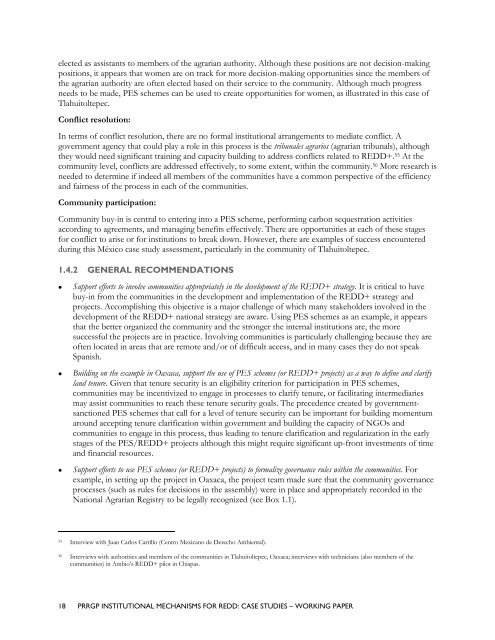Institutional Mechanisms for REDD+ - Case Studies Working Paper
Institutional Mechanisms for REDD+ - Case Studies Working Paper
Institutional Mechanisms for REDD+ - Case Studies Working Paper
Create successful ePaper yourself
Turn your PDF publications into a flip-book with our unique Google optimized e-Paper software.
elected as assistants to members of the agrarian authority. Although these positions are not decision-making<br />
positions, it appears that women are on track <strong>for</strong> more decision-making opportunities since the members of<br />
the agrarian authority are often elected based on their service to the community. Although much progress<br />
needs to be made, PES schemes can be used to create opportunities <strong>for</strong> women, as illustrated in this case of<br />
Tlahuitoltepec.<br />
Conflict resolution:<br />
In terms of conflict resolution, there are no <strong>for</strong>mal institutional arrangements to mediate conflict. A<br />
government agency that could play a role in this process is the tribunales agrarios (agrarian tribunals), although<br />
they would need significant training and capacity building to address conflicts related to <strong>REDD+</strong>. 55 At the<br />
community level, conflicts are addressed effectively, to some extent, within the community. 56 More research is<br />
needed to determine if indeed all members of the communities have a common perspective of the efficiency<br />
and fairness of the process in each of the communities.<br />
Community participation:<br />
Community buy-in is central to entering into a PES scheme, per<strong>for</strong>ming carbon sequestration activities<br />
according to agreements, and managing benefits effectively. There are opportunities at each of these stages<br />
<strong>for</strong> conflict to arise or <strong>for</strong> institutions to break down. However, there are examples of success encountered<br />
during this México case study assessment, particularly in the community of Tlahuitoltepec.<br />
1.4.2 GENERAL RECOMMENDATIONS<br />
� Support ef<strong>for</strong>ts to involve communities appropriately in the development of the <strong>REDD+</strong> strategy. It is critical to have<br />
buy-in from the communities in the development and implementation of the <strong>REDD+</strong> strategy and<br />
projects. Accomplishing this objective is a major challenge of which many stakeholders involved in the<br />
development of the <strong>REDD+</strong> national strategy are aware. Using PES schemes as an example, it appears<br />
that the better organized the community and the stronger the internal institutions are, the more<br />
successful the projects are in practice. Involving communities is particularly challenging because they are<br />
often located in areas that are remote and/or of difficult access, and in many cases they do not speak<br />
Spanish.<br />
� Building on the example in Oaxaca, support the use of PES schemes (or <strong>REDD+</strong> projects) as a way to define and clarify<br />
land tenure. Given that tenure security is an eligibility criterion <strong>for</strong> participation in PES schemes,<br />
communities may be incentivized to engage in processes to clarify tenure, or facilitating intermediaries<br />
may assist communities to reach these tenure security goals. The precedence created by governmentsanctioned<br />
PES schemes that call <strong>for</strong> a level of tenure security can be important <strong>for</strong> building momentum<br />
around accepting tenure clarification within government and building the capacity of NGOs and<br />
communities to engage in this process, thus leading to tenure clarification and regularization in the early<br />
stages of the PES/<strong>REDD+</strong> projects although this might require significant up-front investments of time<br />
and financial resources.<br />
� Support ef<strong>for</strong>ts to use PES schemes (or <strong>REDD+</strong> projects) to <strong>for</strong>malize governance rules within the communities. For<br />
example, in setting up the project in Oaxaca, the project team made sure that the community governance<br />
processes (such as rules <strong>for</strong> decisions in the assembly) were in place and appropriately recorded in the<br />
National Agrarian Registry to be legally recognized (see Box 1.1).<br />
55 Interview with Juan Carlos Carrillo (Centro Mexicano de Derecho Ambiental).<br />
56 Interviews with authorities and members of the communities in Tlahuitoltepec, Oaxaca; interviews with technicians (also members of the<br />
communities) in Ambio‘s <strong>REDD+</strong> pilot in Chiapas.<br />
18 PRRGP INSTITUTIONAL MECHANISMS FOR REDD: CASE STUDIES – WORKING PAPER

















